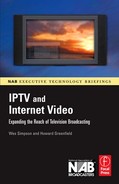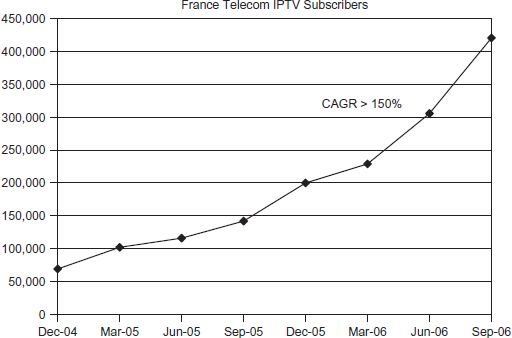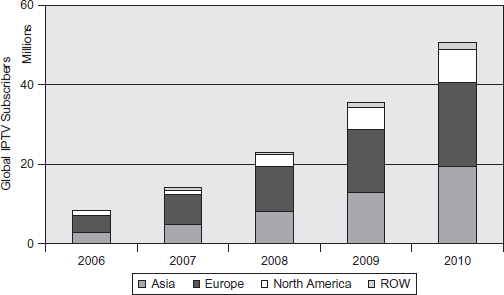1 What is IP, and Why Use it for Video?
Nothing is really real unless it happens on television.
—Daniel J. Boorstin (American social historian and educator)
Before we try to answer this question, it's appropriate to consider what may be obvious – that video transport over Internet Protocol (IP) networks is not only here today, but is poised to become a dominant form of video service delivery for the next 20 years. As it unfolds, new media communications services that only the imagination can anticipate will arise along with it. We are at the dawn of an era that some hail as possibly the most fascinating phase in broadcasting history.
We will discuss the reasons more in this chapter, and the spread of IP will form a subtext throughout the rest of this book. However, there is little doubt that a large and vigorous market is developing though a confluence of improved compression, faster data links, more sophisticated software and evolving viewer habits. So, let's explore these trends, see how they impact network, technology, and business decisions today and, in the final chapter, see where these trends may lead us in the decades ahead.
Digital video is a precisely timed, continuous stream of constant bit rate information, which commonly works on networks where each signal is carried over a network that is purpose-built for video. In contrast, IP networks carry many different kinds of data from a huge variety of sources on a common channel, including e-mail, Web pages, instant messaging, voice over IP (VoIP) and many other types of data. With all of this data flowing together, the Internet is, at best, a loosely timed collection of information that is broken up into discrete packets. Clearly, IP and video don't make an ideal marriage of technologies.
In spite of this fundamental incompatibility, the market for IPTV and Internet Video is exploding. Why? Well, the answer to that question boils down to five basic arguments:
• Because broadband IP networks reach so many households in developed countries, video service providers can use these networks to launch video services without having to build their own networks.
• IP can simplify the task of launching new video services, such as interactive programming, video on demand (VOD) and targeted, viewer-specific advertising.
• The cost of IP networking continues to decline due to the massive volume of equipment produced each year and the existence of worldwide standards.
• IP networks can be found in every country in the world, and the number of users with high-speed Internet connections continues to grow at a rapid pace.
• IP is a perfect technology for many other applications, including data transactions (such as e-mail or banking), local area networking, file sharing, Web surfing and many others.
In this chapter, we will begin with a brief summary of the market trends for IPTV and Internet Video. We will then discuss in greater depth the five forces mentioned above that are driving the migration of video into IP, followed by a look at some issues that need to be addressed by any system trying to send video over an IP network. We'll conclude with a case study of a successful IPTV network installation.
The Corner Office View
“IPTV is a huge growth initiative. It's huge for us, it's huge for our partners. Count the number of TVs, and you don't have to get a lot of money per TV per year to start feeling kind of excited about the size of the opportunity.”
—Steve Ballmer, CEO, Microsoft, speaking to analysts in July 20061
The Internet Protocol
IP provides a mechanism for directing packet flows between devices connected on a network. IP is a common protocol used throughout the Internet and any of the millions of other networks that use IP. Without IP, chaos would reign because there would be no way for one device to send data specifically to another.
At its heart, IP is a standard method for formatting and addressing data packets in a large, multi-function network such as the Internet. A packet is a variable length unit of information (a collection of bytes) in a well-defined format that can be sent across an IP network. Typically, a message such as e-mail or a video signal will be broken up into multiple IP packets. IP can be used on many different network technologies, such as Ethernet LANs, long haul fiber optic and telephony networks, and wireless Wi-Fi links.
A number of different video services operate on IP networks, as we shall see in this book. Applications range all the way from low resolution, low frame rate applications like Webcams to high definition television and medical images. IP technology is incredibly widespread, and a huge variety of video technologies can use IP networks.
The Market for IP Video
So many different video applications can be implemented over IP networks that it can be hard to quantify them, and any attempt to do so will be quickly outdated. Nevertheless, a few facts and figures may be interesting:
• AT&T has begun rollout of Project Lightspeed, an IPTV network intended to be available to 19 million homes in the company's service area by the end of 2008. The company is planning an investment of $4.6 billion to make this a reality.2
• France Telecom had 421,000 ADSL Digital Television (IPTV) subscribers in France as of September 30, 2006. This is an increase of 38 percent over the 306,000 IPTV subscribers reported as of June 30, 2006.3 Figure 1.1 shows the subscriber growth over two years, with a cumulative annual growth rate of more than 150 percent.
Source: Telecom France Financial Reports and Converge Network Digest
FIGURE 1.1 France Telecom's IPTV Subscriber Growth 2004–2006
• Google agreed to acquire YouTube, a leading Web site that allows users to view and upload original videos, for $1.65 billion in October 2006. At the time, YouTube was delivering more than 100 million video views every day and receiving 65,000 video uploads daily.4
• MRG, a market research firm, predicts that the number of global IPTV subscribers will grow from 8.0 million in 2006 to 50.7 million in 2010, a compound annual growth rate of 58 percent.5 See the Reality Check section at the end of this chapter for more detailed information from this study.
The number of applications for video transport over IP networks is large and constantly growing. In this book, we will be focusing on IPTV and Internet Video, both of which are defined in detail in Chapter 2. However, there are a number of other applications that use video transport over IP networks that deserve to be mentioned:
• Videoconferencing has moved out of the realm of dedicated rooms with specialized telecom data circuits into the world of desktop PCs interfacing with IP networks. These systems are characterized by low delay, low bit-rate systems that are suitable for “talking head” video but not much else.
• Webcams have become very popular, particularly for low cost, real-time communication. These systems typically run at very low frame rates (10 or fewer frames per second) and employ very inexpensive digital cameras. These systems can even be configured to work on dial-up connections, although this converts the “video” image into a series of still images with very low resolution.
• Many video surveillance devices intended for use in security applications have migrated to IP technology. There are a number of reasons for this transition, but one of the most compelling is the ability to use existing or easy-to-install Ethernet data cabling in place of coaxial video cables. In these networks, IP protocols and Ethernet cabling is simply used as a means to provide point-to-point connectivity between cameras, video recorders and displays.
• In the world of professional video production, IP networks are used for a variety of purposes (as is the case in many other modern businesses.) IP networks are used to provide connections between video editing workstations and file servers in a production studio. IP networks are used to transmit high quality video files and live feeds from remote venues back to production facilities. And IP networks are used to move video files containing raw footage, finished programming and advertisements to and from virtually every studio, post house and broadcaster in business today.
Not all of the above applications relate directly to the focus of this book, but all of them contribute to the rapidly growing, multi-billion dollar market that constitutes video over IP today.
Arguments in Favor of IP Video
There are a number of reasons companies and individuals decide to transport video signals over IP networks. Three of the most popular revolve around the flexibility of IP networks, their low cost and the incredible coverage that IP networks provide within an organization and around the world. Let's examine each of these arguments in more detail.
IP Network Flexibility
The number of applications of IP networks is truly staggering. The Internet Assigned Numbers Authority (IANA), which maintains the master address book for the Internet, has several thousand well-known and registered ports for different applications that use the IP protocol.6 Some of the most common ones include port 80 for the Hypertext Transfer Protocol (http) that is used by the World Wide Web and ports 25 for Simple Mail Transfer Protocol (smtp) and 110 for Post Office Protocol – Version 3 (pop3) that are used for e-mail.
Counting the number of IP ports is just measuring the tip of the iceberg of IP applications, because many other programs use the protocols that have these port assignments. For example, there are literally dozens of different e-mail programs that work on a variety of different operating systems (Windows, Mac-OS, Linux, etc.) which all communicate by means of the ports defined for smtp and pop3.
Many different devices support IP. In addition to desktop and laptop PCs, servers and mainframes with a variety of different software operating systems can be configured to use IP. In addition, many other devices in the video world have Ethernet ports to allow all sorts of functions, ranging from simple status monitoring and control all the way up to HD video transport.
IP is also very flexible because it is not tied to a specific physical communication technology. IP links have been successfully established over a wide variety of different physical links. One very popular technology for IP transport is Ethernet, which is the dominant network technology in local area networks. Many other technologies can support IP, including dial-up modems, wireless links (such as Wi-Fi), and SONET and ATM telecom links. IP will even work across connections where several network technologies are combined, such as a wireless home access link that connects to a CATV system offering cable modem services, which in turn sends customer data to the Internet by means of a fiber optic backbone.
For broadcasters, this flexibility is important, but it is also a challenge. It is important because it gives broadcasters a choice among a large number of technologies and business models that can be used to deliver content in new formats. It is a challenge because it is impossible to choose a single solution for delivering video over IP networks that will suit all potential viewers.
IP Cost Advantages
Economics is where things start to get interesting, because IP technology has a very low hardware cost. Virtually all new PCs and laptops come equipped with Ethernet ports. A quick scan of the Web shows that Gigabit Ethernet interface cards (which operate at 1,000 Mbps) can be purchased for as little as $15, and they get cheaper all the time. Other infrastructure, such as Ethernet switches, can be purchased for as little as $10 per port. For other networking technologies, such as ATM, SONET or even SDI video routers, costs are typically 10 to 100 times more expensive.
Basic IP software is also very inexpensive or often free. All major computer operating systems include built-in IP software “stacks” that support many different IP services without added cost to the user. This is important not only in commercial applications, but also for home users who might want to access Internet Video services while retrieving their e-mail. This is not to say that all IP video software is inexpensive—far from it. The software necessary to put together a functioning IPTV delivery platform that is scalable to hundreds of video channels and thousands of viewers can easily reach into the millions of dollars.
The low costs of IP networks are of great benefit to broadcasters for two reasons. First, low cost means that much of the network infrastructure needed to connect a video source to a viewer has already been purchased and installed by potential viewers; that which hasn't can affordably be purchased by the broadcaster. Second, as viewer expectations for quality and availability of content grow, putting upward pressure on network bandwidths, broadcasters can safely assume that the IP networks will continue to expand in capacity (which has proven to be a safe assumption for every year over the past three decades.)
IP Ubiquity
IP networks are truly pervasive in the post-millennial world. Both Antarctica and Greenland have over 8,000 Internet hosts each; the United States has 195 million.7 Private IP networks exist in hundreds of millions of homes and businesses around the world—IP is the default technology today when people want to connect two computers together in order to share a printer or an Internet connection. For the traveler, Internet connectivity is available in hotels, airports, coffee shops and via 3G mobile phone data networks in many large cities around the globe.
High-speed data access lines are continuing to be installed at a rapid rate in most developed countries. In the U.S., data collected by the Federal Communications Commission's Wireline Competition Bureau show that by the end of 2005, close to 40 percent of the nation's 109 million households had high-speed access lines in service. This number has been growing by between 3 and 5 million homes every six months for the past three years and shows no sign of abating. Figure 1.2 shows the trend for the past five years.
For broadcasters, the global reach of the Internet is both good and bad. It's good in the sense that anyone in the world with a suitable network connection is part of the potential audience for the broadcaster. (For example, it is perfectly possible to see the local Doppler radar for Connecticut from a hotel room in Tokyo.) It's bad in the sense that the role of the local broadcaster can be fiscally undermined by the disintermediation capability of the Internet. (Viewers in a locality have no need to watch a Hollywood movie by way of their local broadcaster's Web site when they can just as easily get the content directly from the studio's film library.)
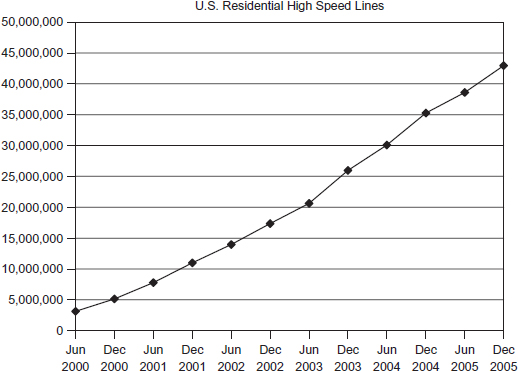
FIGURE 1.2 U.S. Broadband Growth Trends, 2000–20058
Arguments Against IP Video
While there are powerful forces driving the use of IP networks for video transport, it is important to understand some of the potential drawbacks of this new technology. The first argument is primarily economic and revolves around the history of many things on the Internet being free of charge. The second is technical and centers on the difficulty of taking smooth, constant bit rate video signals and adapting them for transmission over IP networks. The third argument focuses on the dilemma of combining video signals that have very high demands for network resources on links that must carry other traffic and determining which uses will get priority. Let's look at each on of these in more detail.
Bad Attitudes About Payment
In some ways, the Internet is still dealing with some bad habits that were established in early days, when content was available for free to anyone who was able to connect. This spirit lives on today in a variety of ways, particularly in the widespread use of illegal file sharing for valuable music and video content.
Any broadcaster hoping to sell content over the Internet needs to be aware of these traditions and expectations and develop a policy to deal with them. One popular method is to deliver the content for free, but to include advertising on the Web site or inserted into the content itself. Another method is to charge fees on a subscription or pay-per-view basis. Both of these options will be discussed more in Chapter 3.
Obtaining legal access to content can also be a challenge. Many content owners have separate licensing terms for different forms of distribution. For example, a movie studio will have different terms and different licensees for each type of release: theatrical, pay-per-view, subscription television, DVD, commercial television and others. Creating a functional team inside a network-based carrier's organization to obtain these licenses can be an expensive and time-consuming process.
Jon Taplin, former CEO of Intertainer, now adjunct professor of communications at the University of Southern California, once related a pertinent anecdote about a conversation he had at a dinner party near the time of the first incarnation of Napster.9 The conversation was with a father who had just surprised his teenage daughter with three music CDs that, through close family research, he knew she would love to have. Her response on receiving the gift was, “Dad! You bought these for me? Why didn't you tell me? We could have just downloaded them off the Internet!”
As the public's perceptions of the Internet mature, and as content owners continue to win high-profile convictions against illegal file sharing, theft of services may become less of an issue. However, it is inevitable that some content will be stolen by some users some of the time. Also, as technology advances, the skills of encryption crackers will increase, forcing improvements to be made to encryption algorithms that modern digital rights management (DRM) are based on. It is incumbent upon content owners to ensure that all of their valuable content is protected with the latest available DRM technology.
Established Viewing Habits
Introducing new viewing habits into large populations of viewers can be difficult and time-consuming. Basic IPTV services closely mirror broadcast television and CATV, but so do viewer expectations about these services. Viewers will expect (and rightly so) that these basic services on IPTV offer a similar level of video quality and system performance to preexisting forms of delivery. More advanced services–such as video on demand and interactive programming–may require viewers to develop new patterns.
While these habits aren't impossible to change (look at the increasing penetration of digital video recorders), there can be a long and expensive learning curve. Plus, IP system operators must be conscious about competitors who create new services that can work over their existing broadcast and CATV facilities. New service providers need to take these factors into account, particularly when creating business plans for exciting new services that may be highly profitable but also require a change in viewing habits.
Network Jitters
Whenever continuous signals like video are cut up into packets for transport over an IP network, difficulties can arise. These mainly stem from the need for the packets to arrive in a timely manner, in the same order they were sent. When this doesn't happen, it places a tremendous burden on the receiving device to properly realign the packets while at the same time doing all of the processing necessary to produce the decoded video output. Some of these variations can be accommodated through the use of memory buffers in the receiving device, but these add delay to the end-to-end video connection.
Broadcasters need to realize that these potential impairments exist, and that there are methods for dealing with problems as they occur. Some of these solutions (such as increasing network bandwidth or replacing network routers) may not only be expensive but also impractical for networks that rely on the Internet.
A Matter of Priority
One of the great benefits of IP networks is the number of different applications that are supported. However, one of the burdens this flexibility places on network administrators is the need to prioritize the applications. Without a priority system, time-critical packets can run into delays caused by congestion of packets from many different flows, which can happen surprisingly often on IP networks.
Unfortunately, the existing mechanisms for handling priority packets on private networks are limited at best. These schemes are also useless on the public Internet, because priority routing is not implemented there. To understand why, consider the dilemma of deciding which packets in the public Internet should receive priority. Each user will, of course, think their packets are more important than those of other users. Without some type of global prioritizing or pricing scheme for different classes of packet service, efforts to add priority filtering to the Internet will be impossible.
Inside private networks, priority systems can be used, but there are still difficulties. Again, the problem arises from determining which types of signals will get priority. The argument for giving video signals priority over other signals is clear, because video signals do not perform well if their packets are delayed or dropped. However, video signals are one of the largest users of bandwidth on most networks and can take up a significant portion of the available capacity. Hence, the dilemma about choosing suitable priority levels can occur on almost any type of IP network.
Pioneer Syndrome
The old cliché about pioneers getting arrows in their backs can certainly be applied to IPTV pathfinders. Because of the complexity and relative immaturity of several of the technologies involved, innovators in IPTV can run into difficulties in a number of areas. One particular area of potential trouble is system integration, where technologies from different suppliers need to be knitted together into a seamless whole. A second area of potential trouble occurs when the network is scaled up to full deployment, where the number of subscribers moves from a few hundred relatively friendly customers to many thousands of paying customers. Large, technically proficient suppliers and system operators have run into problems like these in the past. Companies wishing to install IPTV systems need to recognize that much of this technology is relatively new and unproven and that problems can and will occur.
Reality Check
For this chapter's Reality Checks, we first explore an impressively large forecast that has been published for this market. While the amount of growth projected in this forecast is quite large, it certainly isn't the highest growth projection that we have seen. In the second reality check, we take a look at the IPTV market in France, which must be called a success by any measure.
Market Forecast
By any standard, the market for IPTV services has grown rapidly for the past few years, and industry observers expect that trend to continue. As can be clearly seen on the following charts, the pace of IPTV subscriber growth continues to accelerate. Figure 1.3 shows a forecast of the growth in the number of subscribers worldwide for IPTV from 2006 to 2010. Figure 1.4 shows a forecast of the growth in the amount of service revenue worldwide for IPTV from 2006 to 2010.
IPTV in France
At the IBC in Amsterdam in September 2006, IPTV was a hot topic, and for good reason: service providers were rapidly rolling out IPTV services to consumers all over the planet. Not every venture produces a winner, but there have been a number of successful deployments, and more are on the way. Graeme Packman, of Understanding & Solutions, a UK-based consulting firm, gave a very interesting presentation on IPTV during IBC and provided additional data used here.10
One country where IPTV seemed to be taking hold is in France. Between 2004 and 2006, more than 400,000 subscribers signed up for IPTV service from Orange (France Telecom). Alternative ISP Free provided an IPTV service with more than 80 channels in a package that included Internet access and telephony. About two-thirds of Free's 1.9 million broadband subscribers were eligible for this package. Other IPTV providers included alternative operator Neuf Cegetel, which had recently acquired AOL France, Telecom Italia subsidiary Alice and T-Online (Deutsche Telekom) subsidiary Club Internet.
FIGURE 1.3 IPTV Subscriber Growth Forecast 2006–2010.
Source: © MRG Inc. 2006
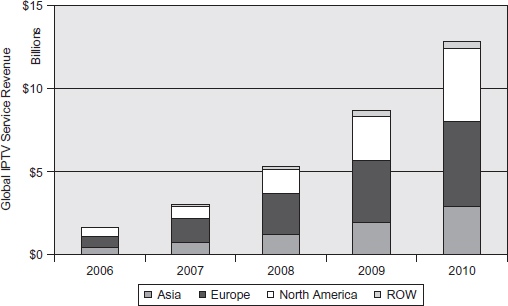
FIGURE 1.4 IPTV Service Revenue Growth Forecast 2006–2010.
Source: © MRG Inc. 2006
11Multimedia Research Group, Inc., publishes market analyses of new technologies for the communications industries and provides market intelligence and strategy consulting for its client companies.
France had an estimated 25 million television households, with approximately 3 million CATV subscribers and 4 million satellite subscribers (in addition to the 1.6 million subscribers with IPTV service available). According to Point-Topic, another UK consultancy,11 France had 11.7 million broadband subscribers as of June 2006, so there were a significant number of potential IPTV subscribers.
The success of IPTV in France occurred for a number of reasons, some of which were specific to the French market and some that may also have been true for other locations:
• Pricing. Due to a very competitive market, the prices for IPTV services were very low. Orange/France Telecom's basic IPTV service with more than 40 channels cost 16 Euros per month. Free's basic triple-play package—which included high speed ADSL2+ Internet access, free voice calls to fixed lines in more than 20 countries and IPTV—cost 30 Euros per month. At this low price, many Free customers were happy purchasing the package just to get Internet and telephone service and didn't utilize the television services. Incumbent Orange started to bundle its basic IPTV service, which includes more than 30 channels, free of charge with some of its broadband access offerings.
• Weak competition. As mentioned above, the main alternatives to IPTV were CATV and satellite, both of which achieved penetration far below levels in other countries. In the case of CATV, up to 2005 there were several cable operators who had not converted the analog base to digital as rapidly as in the UK, and most of these systems were without VOD capability. In the case of satellite TV, penetration was hurt by strict local planning rules that make it impossible for many potential subscribers to mount antennas on their homes. As a result, for many potential viewers, IPTV was possibly the only way to get digital TV services.
• Wide range of content. The channel offerings of the two largest IPTV suppliers were quite extensive. In addition to channels from all over France, both services offered basic-tier international programming from a number of other countries in Europe and the Middle East. In addition, Orange/France Telecom offered more than 200 premium channels. Both operators also partnered with media group Canal+ to offer premium content.
• New services (HD and VOD). While not as important as the reasons mentioned above, both high definition (HD) content and VOD services may have acted to drive subscribers to IPTV. The HD broadcast market in France was much less developed than the U.S. market at the time. IPTV service providers were positioning themselves to capture HD business by deploying HD-capable set top boxes (STBs) early-on. In France, VOD services were also not common, and IPTV providers were, in practicality, the first providers to offer VOD.
Other countries in Europe offered a different picture for IPTV. For example, the UK, a country with roughly the same number of television households as France, had twice as many digital satellite subscribers (more than 7 million). NTL/Telewest operated CATV systems that passed half the homes in the UK and had 3.3 million subscribers. Overall, the penetration of digital TV services in the UK was almost 70 percent of viewers, a much higher ratio than in France or many other countries in Europe. As a result of these and other factors, the penetration of IPTV in the UK was much lower – only 30,000 subscribers as of 2005, according to an article in The Register. UK levels were expected to stay below levels in France for several years following 2006.
Summary
By now, it should be clear that IPTV is a force to be reckoned with today and for the foreseeable future, as powerful market drivers push companies and consumers to adopt this technology. Even though there are a number of issues that must be addressed before IPTV can reach its full potential, these issues are surmountable and are not very different in scope or magnitude from the difficulties that face any new technology.
In this chapter, we covered the basic motivations for using IP networks to deliver video services, including the flexibility, ubiquity and cost advantages that have persuaded many carriers to begin offering these services. We took a look at the market trends that are driving the rapid growth in this market. We then examined several factors pushing the spread of this technology. We concluded with a look at some issues that work against IPTV—although none of these appear to be anything more than the teething pains of a new technology.
1. IPTV International, Volume 2, Issue 2
2. AT&T Corporate press release, May 8, 2006
3. France Telecom press releases, July 27 and October 26, 2006
4. Google/YouTube joint press release, October 9, 2006
5. IPTV Global Forecast—2006 to 2010, Semiannual IPTV Global Forecast, October 2006. Published by Multimedia Research Group, Inc., www.mrgco.com
6. A list of these ports was located at www.iana.org/assignments/port-numbers in August 2006
7. From the CIA Factbook located at www.cia.gov/cia/publications/factbook/fields/2184.html in August 2006
8. From reports published by the FCC's Wireline Competition Bureau, www.fcc.gov/wcb/iatd/stats.html
9. From www.go-associates.com/files/DigitalPiracy.pdf
10. From a presentation entitled “IPTV—Overview and Keys to Success,” September 10, 2006, at IBC, Amsterdam, and subsequent interviews. For more information, please visit www.uands.com
11. Data supplied by private correspondence with Point-Topic www.point-topic.com
